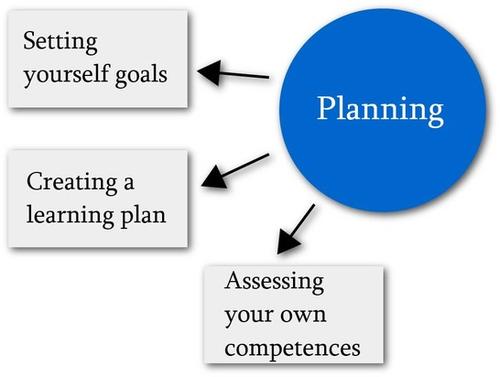Planning
Plan your language learning! You will learn in a more targeted and effective way.
Assessing your own competences
Assess your language skills! What can you already do in the target language?
Use the global scale of the European Framework of Reference for Languages as a guide.
For a more precise self-assessment, use the checklists of the European Language Portfolio or take the DIALANG test at the SLZ.
Setting yourself goals
What do you need the target language competences for? Analyse your language needs:
- Do you need it for studying abroad, for a work placement, for a stay abroad, for your personal interest?
- Do you want to deal with everyday situations (for example shopping, buying a ticket, booking a trip)?
Take time to reflect on your needs. It is worth it! Be specific!
You can use the following worksheets, that you will find at the Center for Independent Language Learning:
- Lernbedürfnisse analysieren (PDF) (in German)
- Lernbedürfnisse Prioritäten setzen (PDF) (in German)
- The goal-setting pyramid (PDF)
Set yourself realistic goals according to your needs, for example:
- I am able to write a job application;
- I am able to write a text about myself, my interests, my studies;
- I am able to talk about my favourite book;
- I am ablet to follow a lecture in my subject;
Find some more specific goals in the checklists of the European Language Portfolio.
Break down your goals into several steps. This will give you a better overview. For example, what does it mean to write an application?
- writing a CV in tabular form;
- writing a cover letter.
What do you need for this?
- CV models in the target language (structure, phrases, vocabulary);
- cover letters in the target language (structure, salutation, closing formulas, phrases, job-specific vocabulary, style);.
What knowledge would you like to consolidate or deepen? For example:
- grammar structures;
- vocabulary;
- sentence structure;
- punctuation;
- text structures.
Creating a learning plan
Create your own learning plan and timetable! You may not be able to stick to it completely, but you will gain an overview of what you have to do and better manage your work.
When creating the learning plan, please consider the following:
- What sub-goals do you want to achieve?
- What materials do you want to work with?
- What tasks do you want to work on?
- Do you want to work alone or with others?
- Where do you want to work?
- For what period of time is your learning plan intended?
Work out a timetable.
Use the following worksheets:
- Einen Lernplan erstellen (PDF) (in German)
- Lernplan (Beispiel für das Niveau A2) (PDF) (in German)
- Lernplan (Beispiel für das Niveau B1) (PDF) (in German)
- Lernplanbogen (PDF) (in German)
- Wochenplanbogen (PDF) (in German)
Write a learning log Lerntagebuch (PDF) (in German)
Check your learning plan during the learning process: Are the priorities still right? The tasks? The timetable? (See monitoring) You can change your learning plan at any time.
